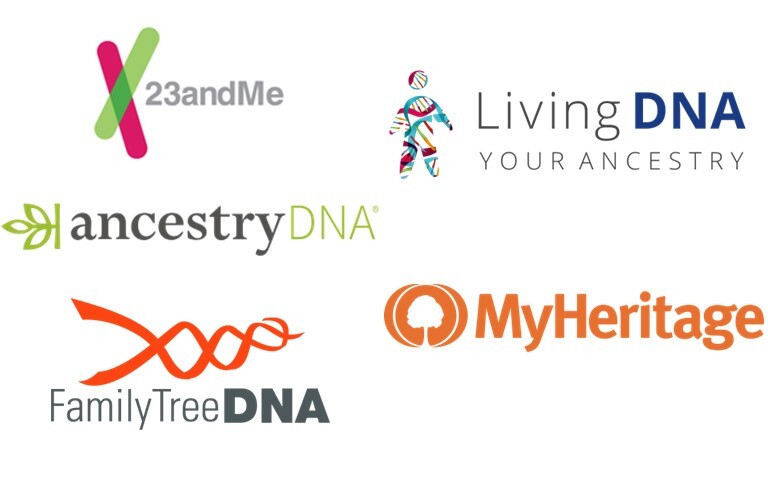Adoptees and others with unknown parentage can use a DNA test to find and connect with their biological families or to learn more about where their ancestors come from. DNA testing won’t always provide a quick answer to finding biological roots, but with some traditional genealogy research and DNA testing, many have found success.
First Step—Taking a DNA Test
Those wanting to connect with their biological family or determine an unknown parent should consider genetic testing. The best DNA test to take for adoptees begins with an autosomal DNA test (atDNA). An autosomal DNA test can be taken by males or females and will provide the adoptee with DNA matches within 5 to 6 generations on both their biological mother's and father’s sides of the family (statistic from ISOGG.org).
Five reputable companies offer genetic testing to the public that include both the ethnicity report and a DNA match list: Ancestry, MyHeritage, 23andMe, Family Tree DNA, and Living DNA. They each offer an atDNA test. The 2 reports, an ethnicity report and a DNA match list, help you to better understand your family tree and to crowdsource with other relatives. Each company may have a different way of naming these 2 important reports. (See the chart below)

Other companies provide genetic testing for the public for various reasons; however, the companies listed above provide the largest DNA-matching databases. Additionally, GEDMatch is a website that does not offer DNA testing but allows the public to upload their raw DNA from other companies to their matching DNA database
DNA Testing with More Than One Company
You may need to test your DNA with more than one company. DNA testing companies compare your DNA to other people who have tested with their company. For this reason, many genetic genealogists suggest adoptees test with multiple DNA companies or upload their raw DNA to other DNA company websites. By testing with more than one company and uploading your raw DNA to additional sites, such as GEDMatch, your DNA will be matched to a bigger pool of potential genetic relatives. You can see which companies allow you to upload your raw DNA from other testing companies in the chart below.
Sensitive Things to Remember Before Testing

Genetic testing has been known to bring numerous secrets to light. You can never unsee or unlearn what the DNA reports tell you. Some of these secrets hidden in our DNA can be very devastating. Prepare yourself as much as possible for what the test may reveal, and seek support from professionals when needed.
Additionally, some adoptees or birth parents wish for privacy and do not want to be identified or have contact. This can sometimes feel like a second abandonment or relinquishment. For this reason, adoptees or birth parents should prepare themselves for this possibility before testing their DNA or before reaching out to DNA matches.
Second Step—Review of DNA Match List Report
What’s a DNA match? A DNA match is a person whom you share DNA with. What is a DNA match list? A DNA match list is a list of names or usernames of all your DNA matches. DNA matches, sometimes referred to as a “cousin-match,” are the result of your DNA data being compared to other people’s DNA data to identify matching segments of chromosomes indicating a family relationship. How closely you are related depends on how many matching segments of DNA you and another person share.
DNA testing companies measure the amount of DNA you share in centimorgans (cM), or they provide you with a percentage. They will also typically provide you with an estimated relationship range.
In the example below, Samuel Darling (name changed to protect privacy) and I share 21.7% (or 1,537.8 cM) of DNA. He is estimated to be my grandfather, a half-brother, or an uncle. It falls to me to determine how he fits into my family tree.

To do this, you can make a complete evaluation of your matches by looking them over in order of those who share the most cM or shared DNA percentages. Take note of your closest matches. Do you have a ½ sibling match? A first-cousin match? A second, third, or more distant cousin match? Though a close match of second-cousin or less is ideal, adoptees may still be successful in connecting with their biological family while learning more about their more distant DNA matches.
Some of the DNA cousin matches will have additional information available for you to review. Additional information may include family surnames, places of origin, or even a family pedigree with names, dates, and places.
If you have no matches closer than a second cousin, it is well worth it to test with another test provider or upload your raw DNA from the first test to another company. You never know which DNA testing company your closest relatives may have tested with. You may also use techniques such as clustering or grouping when you do not have any close matches. You can learn more about these techniques and others at DNA Explained.
| TESTING COMPANY | ETHNICITY REPORT NAME | MATCH LIST NAME | ALLOWS UPLOADS FROM OTHER COMPANIES |
| Ancestry | “Ethnicity Estimate” | “DNA Matches” | No |
| MyHeritage | “Ethnicity Estimate” | “DNA Matches” | Yes |
| 23andMe | “Ancestry Report” | “DNA Relatives” | No |
| Family Tree DNA | “MyOrigins” | “Family Finder Matches” | Yes |
| Living DNA | “Ancestry” | “DNA Relatives” | Yes |
Third Step—Reaching Out
The third step is to reach out to your DNA matches using the testing website’s message system. When using genetic testing to find your biological family, you may want to consider some things before reaching out to them.
- Your DNA match may have gotten a DNA test “just for the fun of it” and never logged into the website again.
- Your DNA match may not know how to help you determine your immediate birth family and may not have a prepared family tree.
- Your birth and subsequent adoption may have been kept a secret from other members of the birth parents’ families.
- Your birth family may not want to make a connection.
- Your birth family members may want to remain unidentified.
With these and many other things to consider, what’s an adoptee to do when they are ready to take the next step and reach out to their biological family? For inspiration, read Jillian’s story of finding and reaching out to her birth father’s family after taking a DNA test.
Jillian’s Story
[Note: Names and specific details have been changed to protect the privacy of others.]
Jillian was adopted at birth, and her main purpose in DNA testing was to learn about her ancestors, where they came from, and to be able to put a family tree of some sort together. But if she found her birth parents in the process, “That would be great,” she recalls.

Jillian tested her DNA but found the process of analyzing her DNA matches overwhelming. She enlisted the help of a professional genealogist.
DNA match lists from multiple testing companies were the key. In no time, the genealogist located a first-cousin match.
Though the first-cousin match did not have a family tree, a family tree was put together for the first-cousin by using other clues and traditional research techniques. Then, with the limited adoption information provided by Jillian, it was determined the first cousin was from her biological father’s side of the family.
Jillian reached out to her match by writing using the testing company’s message system. She shared that she was adopted and what her intent for testing was. After corresponding for a while, Jillian’s first-cousin match helped other cousins test their DNA to determine who Jillian’s father was. Pictures and stories of their shared ancestry followed, and they are looking forward to meeting soon.
Research Help
You may feel overwhelmed searching for your birth family. Even after receiving the DNA test results, it can be a formidable task to weed through the matches. There are many reputable companies and individuals who specialize in helping adoptees find their birth families and analyze DNA results. You might also enjoy learning how to use DNA in genealogy research by engaging in the many free DNA classes at RootsTech.org.
Hope and Support for Adoptees
There are all sorts of wonderful stories showing beautiful reunions of biological families. Many adoptees wish for a similar story of their own. Sadly, this is not the case for all people looking to connect with their biological family.
If you are looking for support after not having an ideal reunion, learning that your birth family doesn’t want to connect, or discovering an unknown parent, many community groups can help, including the following:
These groups can provide guidance, sympathy, and support. They can also advise on how to approach other family members sensitively, as your current and newfound family members may also be affected.
Whether you meet your immediate birth family or not, DNA testing can offer you a way to learn more about your genetic history and where your family comes from. You can begin building your own unique part of your family tree for free on FamilySearch.org, before and after you take a DNA test.
Learn more about FamilySearch’s shared online tree and how it can help you learn about your family, collaborate with cousins and other family members, and do much more!
More about DNA Testing
At FamilySearch, we care about connecting you with your family, and we provide fun discovery experiences and family history services for free. Why? Because we cherish families and believe that connecting generations can improve our lives now and forever. We are a nonprofit organization sponsored by The Church of Jesus Christ of Latter-day Saints. To learn more about our beliefs, click here.




